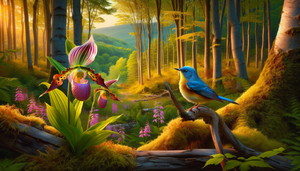Identifying Rare Species in Sugarbushes
Jul 08, 2024
Sugarbush environments, where maple syrup production thrives, are essential for creating this beloved sweetener and housing a diverse range of wildlife. These natural habitats, typically found in Vermont and other northern regions, are home to several rare or protected species. For maple syrup lovers, foodies, and those passionate about sustainability and local produce, learning to identify these species can enhance your appreciation of sugarbushes and contribute to their preservation.
The Rich Biodiversity of Sugarbushes
Sugarbushes, primarily composed of sugar maple trees, create a unique ecosystem. The combination of dense forests, seasonal changes, and abundant resources supports a variety of wildlife. Here's a look at some rare species you might encounter:
Birds
- Cerulean Warbler: A small, sky-blue bird often found in mature forests. Listen for its high-pitched, buzzy song.
- Eastern Whip-poor-will: Known for its distinctive call, this bird is most active at dusk and dawn.
Mammals
- Eastern Small-footed Bat: This tiny bat prefers roosting under loose bark or in rock crevices.
- Canada Lynx: With its tufted ears and large paws, the lynx is adapted to snowy environments.
Plants
- Goldenseal: Recognizable by its bright yellow root, this plant is often found in moist, shaded areas.
- Showy Lady's Slipper: A rare orchid with large, striking flowers, typically blooming in late spring.
Tips for Identifying Rare Species
Identifying rare species in sugarbushes requires patience and a keen eye. Here are some tips to help you spot these elusive creatures:
- Time Your Visit: Early mornings and late afternoons are prime times for wildlife activity.
- Bring Binoculars and a Field Guide: These tools can help you get a closer look and accurately identify species.
- Learn Bird Calls: Many rare birds are easier to hear than to see. Familiarize yourself with their songs.
- Look for Signs: Tracks, nests, and feeding marks can indicate the presence of certain animals.
- Respect Their Habitat: Maintain a safe distance and avoid disturbing the natural environment.
The Importance of Protecting Rare Species
Sugarbushes are more than just syrup-producing areas; they are vital ecosystems that support biodiversity. Protecting these environments ensures that rare species can thrive. Here’s why it's important:
- Ecological Balance: Each species plays a role in the ecosystem, contributing to its health and stability.
- Pollination: Many rare species, like certain birds and bats, are pollinators essential for plant reproduction.
- Cultural Heritage: Preserving these habitats helps maintain the traditional methods of maple syrup production.
How You Can Help
As someone who appreciates maple syrup and its production, you can contribute to the conservation of sugarbushes and their inhabitants:
- Support Sustainable Products: Purchase maple syrup from producers who practice sustainable harvesting.
- Participate in Conservation Efforts: Join local conservation groups or participate in citizen science projects.
- Educate Others: Share your knowledge about the importance of sugarbushes and the species they support.
Frequently Asked Questions (FAQs)
Q: Are there specific times of the year when it's easier to spot rare species in sugarbushes? A: Spring and fall are often the best times due to migratory patterns and breeding seasons.
Q: How can I differentiate between a sugar maple tree and other types of maples? A: Sugar maples have five-lobed leaves with smooth, U-shaped margins, whereas other maples often have serrated edges.
Q: What should I do if I spot a rare or protected species? A: Take a photo, maintain a respectful distance, and report your sightings to local wildlife authorities.


